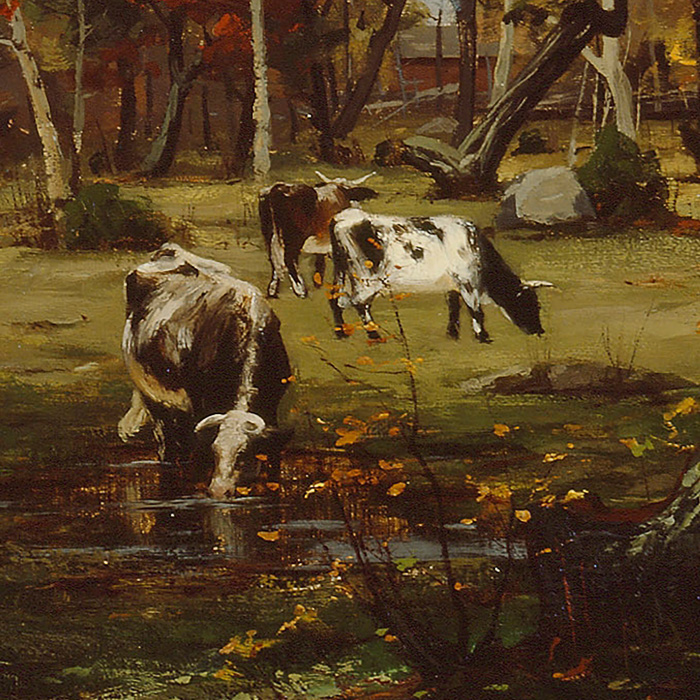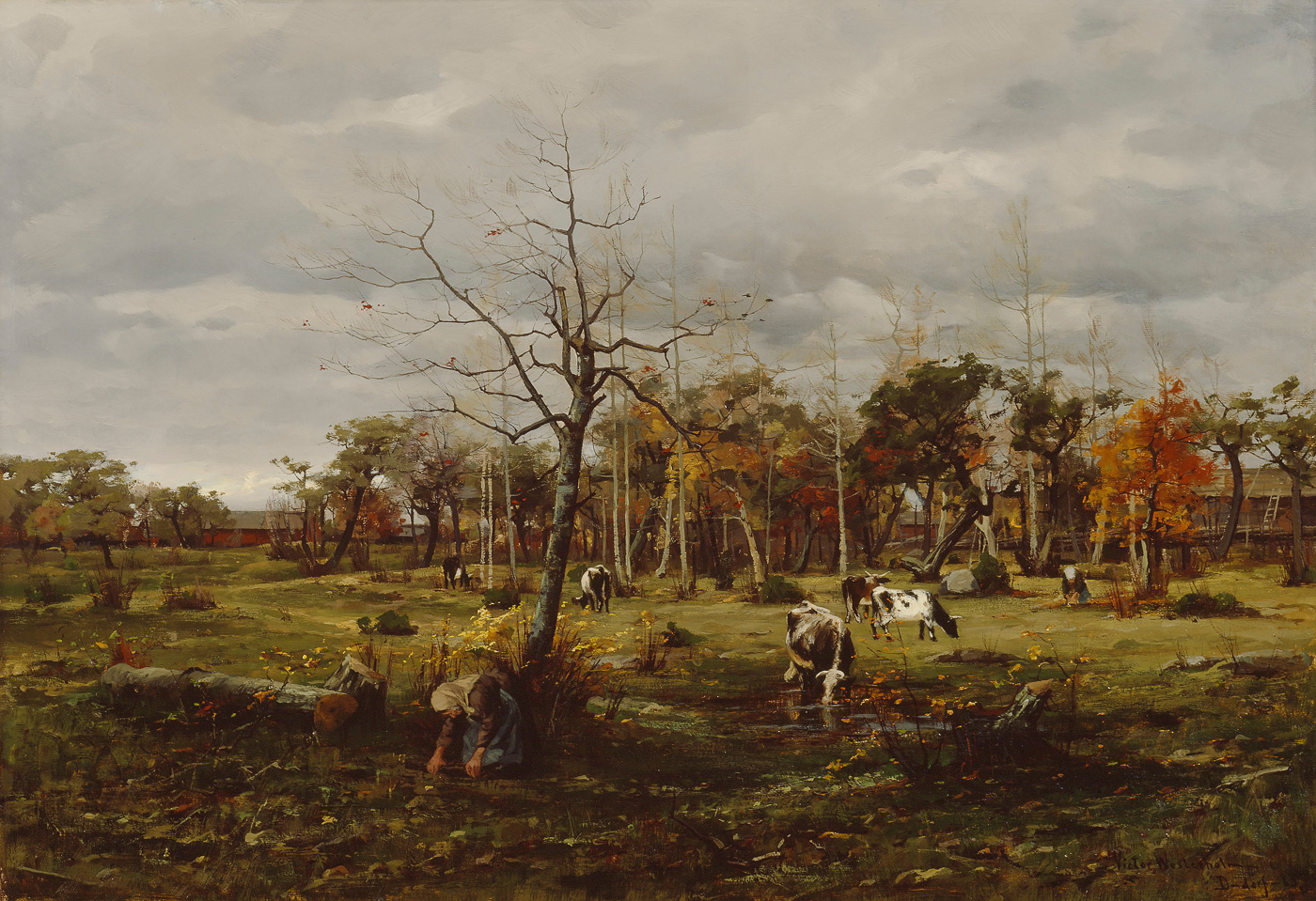

Autumn
Stewardship
Mr. Hadden Turner

Premium Subscribers
Sorry, this feature is only available for H&F Print Premium subscribers. You can sign up here.
(If you are already a Print Premium subscriber, be sure to click the authentication link you were sent by email so this won't happen again.)
As the days become shorter, a coolness begins to tinge the late evening glow. The leaves on the trees turn shades of red, orange, and yellow, as if the forest is somehow on fire without flames. Some begin their descent to their destiny on, and eventually within, the ground below. A proliferation of berries adorns the bushes, providing little gems of energy for the soon-to-be migrating birds, while nuts, raining down from the trees, are hidden away by those creatures who will not be heading south, but will bear the winter at home. Autumn has come.
Autumn is a season of abrupt change. While spring seems to merge seamlessly into summer, autumn’s arrival is more sudden, clearly distinct from all that has preceded it. Once in full flow, autumn can neither be mistaken nor ignored. The most obvious change occurs in the transformation of the trees, of course. And though not as spectacular as fall in the American north, autumn here in the United Kingdom still puts on a sublime display as the leaves turn into colors that are more rustic than vibrant, a source of inspiration for many romantic painters and poets through the ages.
But other changes are also afoot, including those in the sphere of work. While summer and the first weeks of autumn were times of harvest, preparation and preservation are the most earnest works of autumn. And while the work of preparation in spring was for a coming abundance of new life, preparation in autumn is in anticipation of a coming season of shortage and of life returning to the dust. For man and beast alike, the clock is ticking until the scarcities of winter hit. Enduring the long, cold months of winter requires the prudent and earnest stockpiling of food in the fall — on a national level, of course, but on an individual level for smallholders, too. If there is too much feasting today on autumn’s fruit, berries, and nuts or the rewards of the summer harvest, the price will be paid during the long, harsh winter to come. The wise man knows that the more he stores away in autumn and the more he tempers his self-indulgence right now, the more comfortable he will be later. Frugality and patience are the best response to the fruits of autumn.
True, the urge to feast and relax can be intense. The long summer months out in the scorching sun are enough to sap the energy from even the fittest of us. It would indeed be unwise to continue work at the summer’s relentless pace, but labor on the land cannot stop just yet. Harvest is, after all, only half of the work needed for the food to reach our plates. Much of the produce from land must be processed if it is to become edible; other crops need to be preserved to prevent spoilage. The smallholder and farmer must not relax yet, however, for he can still augment the good of the harvest if he embraces frugality and patience, fastidiousness and orderly preparation for just a little longer.
There is no need to grumble about the continual hard work of autumn, however, for preparation can be an enjoyable affair. Canning, preserving, and pickling have all experienced a renaissance in recent times as people rediscover the arts and customs of their grandparents. Preserving was once a vital task for homesteaders whose subsistence lifestyle required them to store away food from their land to sustain them through leaner months. Nowadays, the supermarkets present us with a year-round abundance imported from distant shores, and so the winter famines of yesteryear seem a lost cultural memory. But it is still wise to keep a few cans, jars, and tins in the cupboard just in case of a winter storm. Moreover, there is no better source of winter comfort than food that your own hands have harvested and preserved, and there is no better food to share by the hearth with your neighbors, family, and friends.
 Humans are not the only ones who are preparing throughout the autumn. All around us, animals, both seen and unseen, are making provision for their upcoming winter. Food for them must either be stockpiled in dens and hollows or in layers of fat upon their own bodies. This really is a matter of life and death for these creatures, unlike for those of us who can relatively easily pop down to the store mid-January for another jar of jam. It is a good reminder that we should always be generous in leaving some food and resources available for the creatures who share our neighborhoods and gardens, respecting the hedgerows and milkweed and leaving a few sunflower heads unharvested for the squirrels. It might just be the lifeline they need this year.
Humans are not the only ones who are preparing throughout the autumn. All around us, animals, both seen and unseen, are making provision for their upcoming winter. Food for them must either be stockpiled in dens and hollows or in layers of fat upon their own bodies. This really is a matter of life and death for these creatures, unlike for those of us who can relatively easily pop down to the store mid-January for another jar of jam. It is a good reminder that we should always be generous in leaving some food and resources available for the creatures who share our neighborhoods and gardens, respecting the hedgerows and milkweed and leaving a few sunflower heads unharvested for the squirrels. It might just be the lifeline they need this year.
The land, too, must prepare for future seasons of growth. The hard work of summer has in many cases exhausted the soil, channeling its nutrients into the fruits, seeds, and leaves of the crops. The land is thus in grave need of care and feeding. It is now that the ‘Doctrine of Return’ must be obeyed if we expect the land to yield thriving crops in seasons to come. This means asking ourselves what we can give back to the land to restore its health. The wise farmer and gardener know that there is no such thing as waste in nature’s economy — can we now give back to the land the manure and crop residues from the past year’s work? Indeed, we must, for the land has its limits, and its worthy caretaker will respect and work within these, making sure he replenishes the nutrients that have been lost while also giving the land periodic rest. Autumn stewardship means tending to the hardworking soil with attention and respect.
At this time of year, I find myself turning my own attention toward my backyard crops, for which autumn is a crucial time. Taking up each dead plant, I shake the soil from its roots into a mound of precious earth, a resource far too valuable to dispose of in the garden waste bin. Like all soil that has given fruit this summer, however, my soil is rather spent, its nutrients now in my own body or locked within the decaying stems of my plants. To restore fertility to the soil, I must condition my little mounds of earth with manure and food waste over the months to come; with the help of some composting earthworms, all of this will in time become new, nutrient rich soil. Nothing is wasted in the cycle of life.
The work of preparation does not cease with restoring the land’s fertility, however. The equally vital tasks of sowing and saving soon beckon. Some crops, such as winter wheat, are sown soon after harvest here in the South of England, while the earth is still soft before the hard frosts come. Crops such as salads, kales, and mustards are also sown in autumn because they do best in cooler temperatures. The heat of summer would cause them to bolt and become useless for food.
Most plants cannot survive in cold weather, however, and so I am not so foolish as to try to sow tomato seeds in the autumn months. Yet I can harvest and save my tomato plants’ seeds until next spring, a task that requires both skill and keen observation. The laws of selection dictate that seeds from the best plants should be saved: those plants that have demonstrated pest or disease resistance, superior flavors, or above average yields. Knowing which plants to save seeds from requires that the gardener come to know his plants intimately through sustained and careful attention — a disposition that is also conducive to proper care. Last year, one of my Chocolate Cherry tomato plants produced trusses that yielded twenty or thirty fruits, well above the six-to-eight average. Another yielded fewer fruits, but ones that were substantially larger than those on the rest of my plants. I saved seeds from both of these plants and eagerly await seeing how they perform.
 Autumn’s special work and pleasures happen away from the fields, too. The return of early evening darkness provides opportunities for festivals of warmth and light. Neighborhood bonfires ignite the nights and the sound of giggling children roasting marshmallows or enjoying the spectacle of fireworks can be heard all over the towns and cities of England. These bonfires serve an additional purpose in burning away the leaf litter and twigs that accumulate at this time of year in gardens and upon streets, helping to keep infrastructure unclogged. But here, too, we must exercise prudence and stewardship in our enjoyment: the bracken that is sometimes a nuisance for us can be a home for other creatures, reminding us again that there is no such thing as waste in nature. It is, for example, always a good idea to ensure that no hedgehogs who may have begun their hibernation in the leaf pile meet a grisly end in the bonfire. We can surely spare a few piles and endure a little “untidiness” for our sleeping animal friends.
Autumn’s special work and pleasures happen away from the fields, too. The return of early evening darkness provides opportunities for festivals of warmth and light. Neighborhood bonfires ignite the nights and the sound of giggling children roasting marshmallows or enjoying the spectacle of fireworks can be heard all over the towns and cities of England. These bonfires serve an additional purpose in burning away the leaf litter and twigs that accumulate at this time of year in gardens and upon streets, helping to keep infrastructure unclogged. But here, too, we must exercise prudence and stewardship in our enjoyment: the bracken that is sometimes a nuisance for us can be a home for other creatures, reminding us again that there is no such thing as waste in nature. It is, for example, always a good idea to ensure that no hedgehogs who may have begun their hibernation in the leaf pile meet a grisly end in the bonfire. We can surely spare a few piles and endure a little “untidiness” for our sleeping animal friends.
Before long, the last few leaves will have fallen from the trees, leaving their skeletal forms bare. The sun will surrender its dominion over to the night, and frosts will begin to cover the ground. Perhaps we will even soon see the first few flakes of snow fall from the heavens, a lovely but warning taste of the flurries and blizzards to come. Creatures great and small will slow down, hunker down, and await the frozen months for which autumn has so carefully prepared, and in our homes fireplaces will be kindled once again. Winter is approaching.


